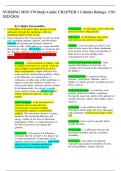NURSING MSN 570 Study Guide CHAPTER 1 Cellular Biology- USU
2023/2024
B) Cellular Permeability:
Is the ability of the cell to allow passage of some Phagocytosis- or cell eating, occurs when this
substances through the membrane, while not process involves solid particles.
permitting others to enter or exit.
Some substances have free passage in and out of the Pinocytosis- or cell drinking, takes place
cells, including enzymes, glucose, and electrolytes. when this process involves a liquid.
Enzymes are proteins that facilitate chemical
reactions in cells, while glucose is a sugar molecule Osmosis- is the movement of water or any
that provides energy. Electrolytes are chemicals that other solvent across the cellular membrane
are charged conductors when they are dissolved in from an area of low solute concentration or
water. Failure of these exchange mechanisms can high water to an area of high solute
lead to the development of disease. concentration or low water.
Diffusion - is the movement of solutes—that Osmotic and hydrostatic pressure - help
is, particles dissolved in a solvent—from an regulate fluid balance in the body; an
area of higher concentration to an area of example can be found in the functioning of
lower concentration. Simple diffusion will the kidneys.
occur until the concentration gradient, which
is the difference in concentrations of Oncotic pressure- is created by plasma
substances on either side of the membrane, is proteins—particularly albumin—and is
equal on each side. Solution is made of a similar to osmotic pressure as higher pressure
solvent and solutes. Solvents dissolve solutes. draws water in.
In the human body, the solvent is usually
water, and the solutes are particles such as Hydrostatic pressure- is created by water
sodium, potassium, glucose, urea, and pushing against the cellular membrane,
oxygen. forcing the water out, which is the opposite of
osmotic pressure, which, when higher, draws
Active Transport- is the movement of a water in.
substance from an area of lower
concentration to an area of higher Osmolality -is the preferred term when
concentration, against a concentration referring to fluids inside the body. Measured
gradient. This movement involves a carrier with osmometer. Normal serum range is 282–
molecule, like facilitated diffusion, but 295.
energy, usually in the form of adenosine
triphosphate (ATP), is required because of Osmolarity is best used to describe fluids
the effort necessary to go against the outside the body.
gradient.
Osmolal gap- is a difference between the
Endocytosis- is the process of bringing a measured osmolality and the calculated
substance into the cell that is too large to go osmolality.
by other mechanisms. Components of the
immune system use endocytosis, particularly Exocytosis- is the release of materials
phagocytosis, to consume and destroy (typically large particles) from the cell onto
bacteria and other foreign material. the cell membrane, usually with the
, NURSING MSN 570 Study Guide CHAPTER 1 Cellular Biology- USU
2023/2024
assistance of a vesicle (a membrane-bound as a measure of response to therapy.
sac).
Energy Production: Chromosomes, DNA, and Genes
Energy is needed to fuel cellular activity. A chromosome - consists of deoxyribonucleic
Cells can obtain energy from two main acid (DNA) and histone and nonhistone
sources—the breakdown of glucose (a proteins. Chromosomes have a well-defined
type of carbohydrate) and the breakdown structure. The
of triglycerides (a type of fat). centromere is an area where the
chromosomes are attached.
Process: Food enters the gastrointestinal
tract, where it is broken down into sugars, Centromere – gives a chromosome its shape,
amino acids, and fatty acids These and because of the shape, genes can be more
substances then are either converted to easily located.
larger molecules (e.g., glucose to
glycogen, amino acids to proteins, and DNA- consists of a nucleotide where genetic
fatty acids to triglycerides and fats), codes are stored.
stored until needed, or metabolized to
make ATP. When used to make ATP, Nucleotide - double helix strand (it looks like
all three sources of energy (amino acids, a twisted rope ladder) made of a sugar
sugars, fatty acids) must first be molecule and phosphate (forms the ladder
converted. Sugars, through the process of sides) attached to a nitrogen containing base
glycolysis (splitting), becomes pyruvate (forms the ladder steps).
in the cytoplasm. If oxygen is present
(i.e., through an aerobic process), Chromatin- DNA that is combined and
pyruvate then becomes acetyl coenzyme wrapped around the histone proteins.
A (acetyl CoA). Acetyl CoA is also
derived from amino acids and fatty acids. 99% DNA -NUCLEUS
1% of DNA – Mitochondria
Krebs cycle (citric acid cycle or
tricarboxylic cycle)- which is a high- Genome- complete set of DNA and genes.
electron-producing process that occurs in
the mitochondria, these molecules go Base pair- Adenine/Thymine
through a complex series of reactions that
result in the production of large amounts Genotype- Transmitted gene information
of ATP.
Karyotype- Blueprint
Lactate - is produced from lactic acid and can
be used as a measure of disease severity. Phenotype- Detectable outward expression of
the genotype. Only about 1% of DNA has
Lactate levels - can rise and can eventually genes that make up a person.
lead to lactic acidosis. Lactate levels are used
as a measure of disease severity and outcome
or




